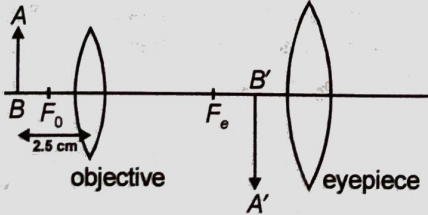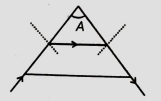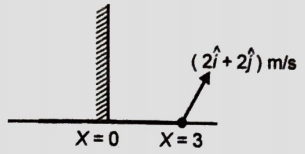The focal length of a convex lens is \(40~\text{cm}\) cm and the size of the inverted image formed is half of the object. The distance of the object is:
1.
\(60~\text{cm}\)
2.
\(120~\text{cm}\)
3.
\(30~\text{cm}\)
4.
\(180~\text{cm}\)
The condition of minimum deviation is achieved in an equilateral prism kept on the prism table of a spectrometer. If the angle of incidence is \(50^{\circ}\), the angle of deviation is:
1. \(25^{\circ}\)
2. \(40^{\circ}\)
3. \(50^{\circ}\)
4. \(60^{\circ}\)
A small air bubble is at the centre of a glass sphere of radius 10 cm and refractive index 1.5. The distance of the bubble from the surface, when viewed from outside the sphere, is
(1) 2.5 cm
(2) 5 cm
(3) 7.5 cm
(4) 10 cm
Focal lengths of objective and eyepiece of a compound microscope are 2 cm and 6.25 cm respectively. An object AB is placed at a distance of 2.5 cm from the objective which forms the image A'B' as shown in the figure. Maximum magnifying power in this case is

1. 10
2. 20
3. 5
4. 25
The refractive index of the material of prism is . The angle of prism A is equal to

(1) 30
(2) 40
(3) 60
(4) 90
An object is placed \(20~\text{cm}\) in front of a concave mirror of a radius of curvature \(10~\text{cm}.\) The position of the image from the pole of the mirror is:
1. \(7.67~\text{cm}\)
2. \(6.67~\text{cm}\)
3. \(8.67~\text{cm}\)
4. \(9.67~\text{cm}\)
A plane mirror is moving with velocity . A point object in front of the mirror moves with a velocity here is along the normal to the plane mirror and facing towards the object. The velocity of the image is
1.
2.
3.
4.
A candle is held \(3\) cm away from a concave mirror of focal length \(12\) cm, then the nature of the image formed by the mirror is:
1. real, inverted
2. virtual, erect
3. real, erected
4. virtual, inverted
A plane mirror is placed at x = 0 along the y-axis and an object starts moving with velocity m/s from x = 3. Relative velocity of the image in the mirror with respect to the object is:

1. 4 m/s along the -x-axis
2. 4 m/s along the +x axis
3. m/s making an angle of with the +x axis
4. m/s making an angle of with the +x axis
The angle of minimum deviation for a glass prism of refractive index \(\mu = \sqrt{3}\) equals the refracting angle of the prism. The angle of the prism is:
1. \(30^{\circ}\)
2. \(60^{\circ}\)
3. \(90^{\circ}\)
4. \(45^{\circ}\)






